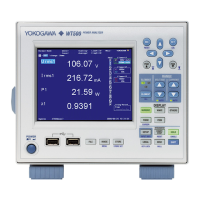7-20
IM 760201-01E
Selecting a Cursor Path
Because the WT500 uses P-P compression on sampled data (see section 2.7 for
details), two values (a maximum and a minimum value) are displayed at each time-axis
point. You can choose the path that the cursors move through and the data points that
are measured by the cursors from one of the options below.
•
Max
Cursors move along and measure the maximum values on the time axis.
• Min
Cursors move along and measure the minimum values on the time axis.
• Mid
Cursors move through the middles of the maximum and minimum values on the time
axis, and they measure the values in the middle of the maximum and minimum values.
Moving the Cursors
• Cursors move along the selected waveform.
• Cursors can be moved anywhere between the left and right edges of the display.
• The unit of cursor movement is the amount of time contained in one screen ÷ 500.
• When the cursor positions are linked, increasing or decreasing the setting for one
cursor will increase or decrease the setting for the other cursor by the same amount.
Note
• If a cursor encounters immeasurable data, “***” is displayed in the measured value display
area.
•
Δ
Y can be measured even when the units of the cursors are different. The measured result
will not have a unit.
•
The range of the vertical axis that can be measured using cursors is within ±300% when the
crest factor is set to 3 and within ±600% when the crest factor is set to 6.
7.9 Measuring with Cursors

